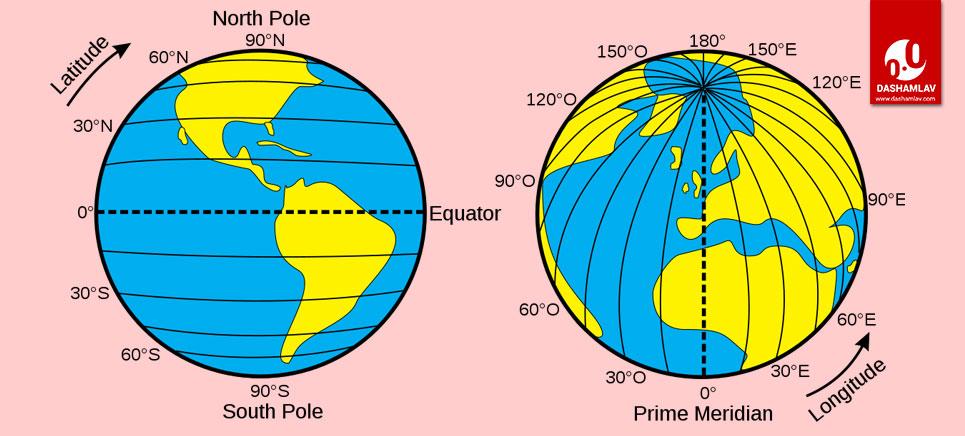It is very difficult to locate a geographical location on our planet earth without any reference. Some universal reference point is required for locating the exact position of any place on the earth’s surface. Good thing is that we have such a reference available. It is based on two main geographical coordinates called latitude and longitude.
Latitudes are vertical imaginary lines that help us in locating the north-south position of a location. Longitudes, on the other hand, are the horizontal imaginary lines that help us in locating the east-west position of a location. The following table enlists the key differences between latitudes and longitudes.
| Latitude | Longitude |
|---|---|
| Lines/parallels of latitude go from east to west. | Lines of longitude go from north to south. |
| It is used for measuring distances that are north or south of the equator. | It is used for measuring distances that are east or west of the Prime Meridian. |
| There are a total of 180 degrees of latitudes. | There are a total of 360 meridians of longitudes. |
| Lines of latitude are commonly referred to as parallels of latitude. They run parallel to each other and never meet. | Lines of longitude are commonly referred to as meridians of longitude. These lines run around the earth vertically up-down and meet at the poles. |
| The Equator (zero degrees latitude) is the middle latitude. It is the largest latitude and it divides Earth into the northern and southern hemispheres. | Prime Meridian at Greenwich is chosen as the zero degrees longitude. It creates a circle on Earth along with International Date Line (180-degree meridian). This circle divides the Earth into the eastern and western hemispheres. |
| Latitudes are imaginary lines run parallel and never meet. | Longitudes are imaginary lines meet the poles and they do not run parallel. |
| Parallels of latitude classify heat zones. | Meridians of longitude classify time zones. |
| The Equator is the longest parallel of latitude. The length of latitude decreases as we move from the equator to the poles. | The length of all the longitude is the same. |
Diagram of Latitudes and Longitudes
Important Facts About Latitude and Longitude
Important Parallels and Meridians
There are five important parallels of latitude. These are as follows:
- Equator (0° Latitude)
- Tropic of Cancer (23½° N of Equator)
- Tropic of Capricorn (23½° S of Equator)
- Arctic Circle (66½° N of Equator)
- Antarctic Circle (66½° S of Equator)
There are mainly two main important meridians of longitude. These are as follows:
- Prime Meridian (0° Longitude): It is also known as Greenwich Meridian as it passes through Greenwich near London where the original site of British Royal Observatory is located. This meridian also serves as the basis of different time zones of the world.
- Anti Meridian of Prime Meridian (180° Longitude): The anti-meridian( +/- 180-degree line of longitude) of Prime Meridian is exactly opposite to the Prime Meridian. It is mostly in alignment with the International Date Line (IDL) which demarcates the change of one calendar day. While in most places the anti-meridian and IDL coincide, IDL deviates from anti-meridian in east or west direction at some places. These deviations have been made to satisfy the political and economic requirements of the areas through which the anti-meridian passes.
Unit of Latitude & Longitude
The primary unit of both latitude and longitude is degrees (°) which is 1/360 of a full circle. Each degree can be divided into 60 minutes. Similarly, each minute can be divided into 60 seconds.
Meeting Point of 0° Latitude and 0° Longitude
Null Island is the meeting point of Equator (0° Latitude) and the Prime-Meridian(0° Longitude). It is located in the international waters off the West African Coast in the Gulf of Guinea (Atlantic Ocean).
Use the citation below to add this article to your bibliography
"Difference Between Latitude & Longitude: With Table and Diagrams." Dashamlav.com. Web. 11 June 2025. <https://dashamlav.com/latitude-vs-longitude-difference-table-diagram/>
Dashamlav.com, "Difference Between Latitude & Longitude: With Table and Diagrams." Accessed 11 June 2025. https://dashamlav.com/latitude-vs-longitude-difference-table-diagram/
"Difference Between Latitude & Longitude: With Table and Diagrams." (n.d.). Dashamlav.com. Retrieved 11 June 2025 from https://dashamlav.com/latitude-vs-longitude-difference-table-diagram/

